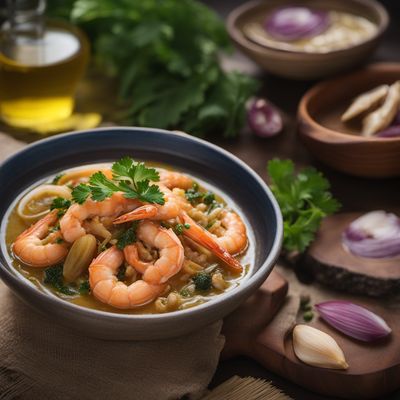
Ingredient
Cheese, manchego
The Spanish Delight
Manchego cheese is a semi-firm cheese with a pale yellow color and a distinctive zigzag pattern on its rind. It has a buttery and slightly tangy taste, with a firm and crumbly texture. This cheese is commonly used in Spanish cuisine, particularly in tapas, sandwiches, and cheese platters.
Origins and history
Manchego cheese originated in the La Mancha region of Spain and has a long history dating back to the time of the Romans. It is named after the breed of sheep, Manchega, whose milk is used to make this cheese. Manchego cheese is deeply rooted in Spanish culture and is protected by a Designation of Origin (D.O.) status.
Nutritional information
Manchego cheese is a good source of protein and calcium. It also contains vitamins A and B12, as well as minerals like zinc and phosphorus. However, it is high in saturated fat and sodium, so it should be consumed in moderation.
Allergens
Manchego cheese may contain lactose and is not suitable for individuals with lactose intolerance. It is also not suitable for vegans or those with dairy allergies.
How to select
When selecting Manchego cheese, look for a cheese with a firm texture and a natural rind. The cheese should have a pleasant aroma and a slightly sweet and nutty smell. Avoid any signs of mold or excessive dryness. Opt for cheeses that have been aged for at least three months for a more pronounced flavor.
Storage recommendations
To maintain the freshness of Manchego cheese, store it in the refrigerator wrapped in wax paper or parchment paper. This will help prevent the cheese from drying out. It is best consumed within a few weeks of purchase.
How to produce
Manchego cheese is produced by using sheep's milk, which is curdled and then pressed into molds. The cheese is then aged for a minimum of two months, but it can be aged for up to two years for a stronger flavor. The aging process gives Manchego cheese its characteristic taste and texture.
Preparation tips
Manchego cheese can be enjoyed on its own or paired with fruits, nuts, and cured meats. It is commonly used in Spanish tapas, such as grilled cheese sandwiches, cheese platters, and salads. It can also be melted and used in dishes like quesadillas or gratins.
Culinary uses
Manchego cheese is widely used in Spanish cuisine, particularly in tapas, sandwiches, and cheese platters. It is often enjoyed with quince paste or honey for a sweet and savory combination. Manchego cheese is also a popular ingredient in traditional Spanish dishes like paella and empanadas.
Availability
Manchego cheese is primarily produced in the La Mancha region of Spain. It is also available in specialty cheese shops or gourmet stores in other countries.
More ingredients from this category » Browse all

Cheese, zamorano
The Spanish Delight: Unveiling the Richness of Zamorano Cheese

Cheese, formai de mut
The Aged Treasure

Cheese, san simon
The Smoky Delight of San Simon Cheese

Cheese, ubriaco
"Aged to Perfection: Exploring the Unique Flavors of Ubriaco Cheese"

Cheese, pecorino romano
The Bold and Savory Delight: Pecorino Romano Cheese

Cheese, grana padano
The King of Italian Cheeses: Grana Padano

Cheese, comte
The King of French Cheeses

Cheese, afuega'l pitu
The Fiery Delight: Exploring the Bold Flavors of Afuega'l Pitu Cheese

Cheese, sbrinz
The Alpine Delight: Sbrinz Cheese

Cheese, caciocavallo
The Versatile Italian Delight

Cheese, fiore sardo
The Sardinian Delight: Fiore Sardo Cheese

Cheese, ragusano
The Sicilian Delight
Recipes using Cheese, manchego » Browse all

Asturian-style Laksam
Creamy Seafood Delight: Asturian-style Laksam

Castilian-Manchego Inspired Indian Canapés
Spicy Tapas Delight: Castilian-Manchego Inspired Indian Canapés

Andalusian-style Su Böreği
Flaky Andalusian Delight: Su Böreği with a Spanish Twist

Latin American Cordon Bleu
Sabor Latino Cordon Bleu - A Latin Twist on a Classic Dish

Queso con Anchoas al Horno (Baked Cheese with Anchovies)
Savory Delight: Baked Cheese with Spanish Anchovies

Galician-style Pizza Mimosa
Savory Galician Delight: Pizza Mimosa with a Twist

Spanish-style Gyoza
Tapas Twist: Spanish-inspired Gyoza Delight

Bocadillo de Sobrasada with Manchego Cheese and Honey
Spanish Delight: Savory Sobrasada Sandwich with a Sweet Twist

Castilian-Manchego Style Margherita Pizza
Sabor Español: A Spanish Twist on Margherita Pizza

Fettuccine con Salsa de Mantequilla y Parmesano
Delicioso Fettuccine con Salsa de Mantequilla y Parmesano

Cuban-Style Pasta Carbonara
Havana Carbonara: A Cuban Twist on a Classic Italian Dish

Spanish-style Ramen
Ravishing Ramen with a Spanish Twist